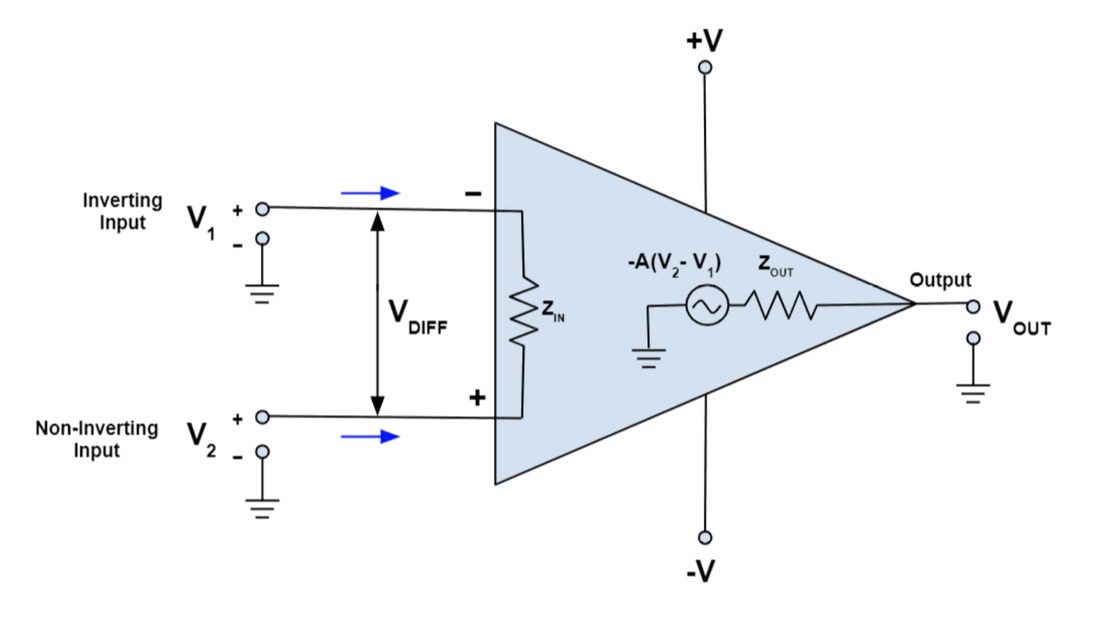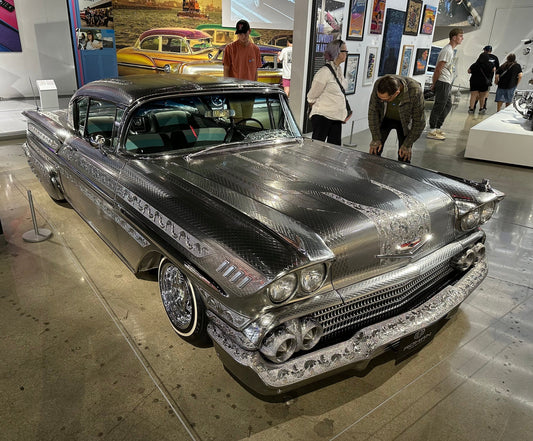 Where you see V1 and V2, those are inputs, and where you see Vout that's the output. Rf is the feedback value.
Using this gain block one can easily make all sorts of amplifying circuits from balanced inputs, to phase swappers, to buffers, to phono preamplifiers.
(Here's a link to an ancient paper showing how to make 41 audio projects using a chip op-amp. Note: the author uses a 741 op-amp in his designs. The 741 op-amp is perhaps the single worst choice in the entire world for building audio circuits. Perhaps there's something worse, but in my near-50 years, I have yet to find one. Use instead the venerable NE 5532 op-amp, which sounds great).
Many of PS Audio's products are based on op-amp topology though we rarely rely upon the chip versions because for best sound quality, we require more control over the amplifier's performance. Instead, we often build discrete versions of the operational amplifier topology using higher voltage rails and hand-selected devices to best suit our needs.
The point of this post is to set the record straight. Op-amps are not necessarily chips and chips are not necessarily op-amps.
I'm just protecting the good name and reputation of a core fundamental gain block of audio.
Where you see V1 and V2, those are inputs, and where you see Vout that's the output. Rf is the feedback value.
Using this gain block one can easily make all sorts of amplifying circuits from balanced inputs, to phase swappers, to buffers, to phono preamplifiers.
(Here's a link to an ancient paper showing how to make 41 audio projects using a chip op-amp. Note: the author uses a 741 op-amp in his designs. The 741 op-amp is perhaps the single worst choice in the entire world for building audio circuits. Perhaps there's something worse, but in my near-50 years, I have yet to find one. Use instead the venerable NE 5532 op-amp, which sounds great).
Many of PS Audio's products are based on op-amp topology though we rarely rely upon the chip versions because for best sound quality, we require more control over the amplifier's performance. Instead, we often build discrete versions of the operational amplifier topology using higher voltage rails and hand-selected devices to best suit our needs.
The point of this post is to set the record straight. Op-amps are not necessarily chips and chips are not necessarily op-amps.
I'm just protecting the good name and reputation of a core fundamental gain block of audio.
Op amps vs. chips
by Paul McGowan
I wince when people equate op-amps with chips.
An op-amp describes a topology, not a chip.
Yes, the op-amp topology is often built onto a silicon wafer, but we should be careful not to forever bind the two together unless we're clear about the difference.
(If you're technically minded there's a great paper describing in detail the nature of op-amps from some of my engineering heroes you can read here or, for those less technical but still interested, my friend and audio superstar, Nelson Pass published this great and easier to understand work).
Op-amps have been around since the 1930s. They were originally built using vacuum tubes. The term itself, op-amp, is short for Operational Amplifier.
There are multiple types of op-amps, but for our purposes, we'll focus on the standard voltage amplifier so often used in audio circuits.
A simple description of an op-amp is an analog circuit block that takes a differential voltage input and produces a single-ended voltage output. Here's a simple diagram.
 Where you see V1 and V2, those are inputs, and where you see Vout that's the output. Rf is the feedback value.
Using this gain block one can easily make all sorts of amplifying circuits from balanced inputs, to phase swappers, to buffers, to phono preamplifiers.
(Here's a link to an ancient paper showing how to make 41 audio projects using a chip op-amp. Note: the author uses a 741 op-amp in his designs. The 741 op-amp is perhaps the single worst choice in the entire world for building audio circuits. Perhaps there's something worse, but in my near-50 years, I have yet to find one. Use instead the venerable NE 5532 op-amp, which sounds great).
Many of PS Audio's products are based on op-amp topology though we rarely rely upon the chip versions because for best sound quality, we require more control over the amplifier's performance. Instead, we often build discrete versions of the operational amplifier topology using higher voltage rails and hand-selected devices to best suit our needs.
The point of this post is to set the record straight. Op-amps are not necessarily chips and chips are not necessarily op-amps.
I'm just protecting the good name and reputation of a core fundamental gain block of audio.
Where you see V1 and V2, those are inputs, and where you see Vout that's the output. Rf is the feedback value.
Using this gain block one can easily make all sorts of amplifying circuits from balanced inputs, to phase swappers, to buffers, to phono preamplifiers.
(Here's a link to an ancient paper showing how to make 41 audio projects using a chip op-amp. Note: the author uses a 741 op-amp in his designs. The 741 op-amp is perhaps the single worst choice in the entire world for building audio circuits. Perhaps there's something worse, but in my near-50 years, I have yet to find one. Use instead the venerable NE 5532 op-amp, which sounds great).
Many of PS Audio's products are based on op-amp topology though we rarely rely upon the chip versions because for best sound quality, we require more control over the amplifier's performance. Instead, we often build discrete versions of the operational amplifier topology using higher voltage rails and hand-selected devices to best suit our needs.
The point of this post is to set the record straight. Op-amps are not necessarily chips and chips are not necessarily op-amps.
I'm just protecting the good name and reputation of a core fundamental gain block of audio.
 Where you see V1 and V2, those are inputs, and where you see Vout that's the output. Rf is the feedback value.
Using this gain block one can easily make all sorts of amplifying circuits from balanced inputs, to phase swappers, to buffers, to phono preamplifiers.
(Here's a link to an ancient paper showing how to make 41 audio projects using a chip op-amp. Note: the author uses a 741 op-amp in his designs. The 741 op-amp is perhaps the single worst choice in the entire world for building audio circuits. Perhaps there's something worse, but in my near-50 years, I have yet to find one. Use instead the venerable NE 5532 op-amp, which sounds great).
Many of PS Audio's products are based on op-amp topology though we rarely rely upon the chip versions because for best sound quality, we require more control over the amplifier's performance. Instead, we often build discrete versions of the operational amplifier topology using higher voltage rails and hand-selected devices to best suit our needs.
The point of this post is to set the record straight. Op-amps are not necessarily chips and chips are not necessarily op-amps.
I'm just protecting the good name and reputation of a core fundamental gain block of audio.
Where you see V1 and V2, those are inputs, and where you see Vout that's the output. Rf is the feedback value.
Using this gain block one can easily make all sorts of amplifying circuits from balanced inputs, to phase swappers, to buffers, to phono preamplifiers.
(Here's a link to an ancient paper showing how to make 41 audio projects using a chip op-amp. Note: the author uses a 741 op-amp in his designs. The 741 op-amp is perhaps the single worst choice in the entire world for building audio circuits. Perhaps there's something worse, but in my near-50 years, I have yet to find one. Use instead the venerable NE 5532 op-amp, which sounds great).
Many of PS Audio's products are based on op-amp topology though we rarely rely upon the chip versions because for best sound quality, we require more control over the amplifier's performance. Instead, we often build discrete versions of the operational amplifier topology using higher voltage rails and hand-selected devices to best suit our needs.
The point of this post is to set the record straight. Op-amps are not necessarily chips and chips are not necessarily op-amps.
I'm just protecting the good name and reputation of a core fundamental gain block of audio.
- Choosing a selection results in a full page refresh.
- Opens in a new window.









